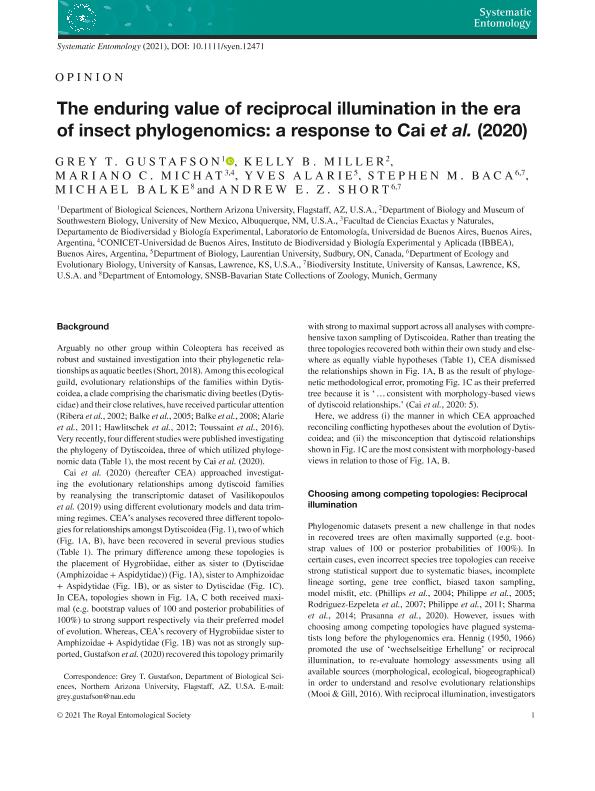Artículo
The enduring value of reciprocal illumination in the era of insect phylogenomics: a response to Cai et al. (2020)
Gustafson, Grey T.; Miller, Kelly B.; Michat, Mariano Cruz ; Alarie, Yves; Baca, Stephen M.; Balke, Michael; Short, Andrew E. Z.
; Alarie, Yves; Baca, Stephen M.; Balke, Michael; Short, Andrew E. Z.
 ; Alarie, Yves; Baca, Stephen M.; Balke, Michael; Short, Andrew E. Z.
; Alarie, Yves; Baca, Stephen M.; Balke, Michael; Short, Andrew E. Z.
Fecha de publicación:
02/2021
Editorial:
Wiley Blackwell Publishing, Inc
Revista:
Systematic Entomology (print)
ISSN:
0307-6970
Idioma:
Inglés
Tipo de recurso:
Artículo publicado
Clasificación temática:
Resumen
Arguably no other group within Coleoptera has received as robust and sustained investigation into their phylogenetic relationships as aquatic beetles. Among this ecological guild, evolutionary relationships of the families within Dytiscoidea, a clade comprising the charismatic diving beetles (Dytiscidae) and their close relatives, have received particular attention. Very recently, four different studies were published investigating the phylogeny of Dytiscoidea, three of which utilized phylogenomic data, the most recent by Cai etal. (2020). Cai et al. (2020) (hereafter CEA) approached investigating theevolutionary relationships among dytiscoid families by reanalysing the transcriptomic dataset of Vasilikopoulos et al. (2019) using different evolutionary models and data trimming regimes. CEAs analyses recovered three different topologies for relationships amongst Dytiscoidea, two of which have been recovered in several previous studies. The primary difference among these topologies is the placement of Hygrobiidae, either as sister to (Dytiscidae (Amphizoidae + Aspidytidae)), sister to Amphizoidae + Aspidytidae, or as sister to Dytiscidae. In CEA, topologies shown in Fig. 1A, C both received maximal (e.g. bootstrap values of 100 and posterior probabilities of 100%) to strong support respectively via their preferred model of evolution. Whereas CEAs recovery of Hygrobiidae sister to Amphizoidae + Aspidytidae was not as strongly supported, Gustafson et al. (2020) recovered this topology primarily with strong to maximal support across all analyses with comprehensive taxon sampling of Dytiscoidea. Rather than treating the three topologies recovered both within their own study and elsewhere as equally viable hypotheses, CEA dismissed the relationships shown in Fig. 1A, B as the result of phylogenetic methodological error, promoting Fig. 1C as their preferred tree because it is consistent with morphology-based views of dytiscoid relationships. Here, we address (i) the manner in which CEA approached reconciling conflicting hypotheses about the evolution of Dytiscoidea; and (ii) the misconception that dytiscoid relationships shown in Fig. 1C are the most consistent with morphology-based views in relation to those of Fig. 1A, B.
Palabras clave:
HYDRADEPHAGA
,
HYGROBIIDAE
,
DYTISCIDAE
,
AMPHIZOIDAE
,
ASPIDYTIDAE
Archivos asociados
Licencia
Identificadores
Colecciones
Articulos(IBBEA)
Articulos de INSTITUTO DE BIODIVERSIDAD Y BIOLOGIA EXPERIMENTAL Y APLICADA
Articulos de INSTITUTO DE BIODIVERSIDAD Y BIOLOGIA EXPERIMENTAL Y APLICADA
Citación
Gustafson, Grey T.; Miller, Kelly B.; Michat, Mariano Cruz; Alarie, Yves; Baca, Stephen M.; et al.; The enduring value of reciprocal illumination in the era of insect phylogenomics: a response to Cai et al. (2020); Wiley Blackwell Publishing, Inc; Systematic Entomology (print); 46; 3; 2-2021; 473-486
Compartir
Altmétricas



